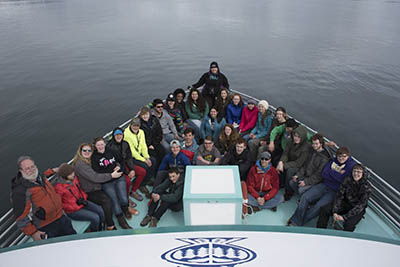By Lisa Matlock
Outreach Coordinator

I was a Homer resident for five years. Each spring I watched a fleet of fishing boats carrying noisy, funny-looking machines and pulling long orange and yellow lines around in circles near the Spit. I can remember asking, “What are they doing out there?” The answer was always, “Oh, that’s just SERVS training.” I never learned more than that until my first year with the council when I had the opportunity to observe that training personally.
For two days, I participated in classroom training with a group of fishermen and other mariners about spill safety, oil spill tactics, wildlife protection, and Geographic Response Strategies for sensitive areas. I learned about different types of hydraulic power packs, skimmers, and oil containment boom. Classroom work culminated in an all-day on-water training, with the fleet of local Homer boats out doing what I had only wondered about years before. Not only did I finally understand what the training was, I also learned more about oil spill response in three days than in my weeks of reading at my desk in the office. I decided that everyone in the Exxon Valdez oil spill region could benefit by understanding what their local fishermen and mariners were out there doing each year, and how their community is ready to respond in the case of an oil spill. And the council agrees!
Alyeska’s oil spill response organization, Ship Escort/Response Vessel System, also known as SERVS, was established in 1990 after the Exxon Valdez oil spill. The SERVS fleet includes large, open-water oil spill response vessels, barges, and equipment along with tugs that escort tankers in and out of Prince William Sound. As part of their commitment to prevent and respond to oil spills, Alyeska also contracts with fishing, charter, and other local vessels to provide open water response as well as critical nearshore response and sensitive area protection fleet. As part of those contracts, SERVS travels every year to the communities of Cordova, Valdez, Whittier, Seward, Homer, and Kodiak to conduct oil spill response training for the crews of these vessels.
Many oil spill response organizations worldwide use a “Vessel of Opportunity” program, which is simply a list of local vessels that may be available in case of response. Those vessels are not on contract or paid to be readily available if a spill were to occur; they are not trained each year with the most cutting edge equipment used to clean up a spill; nor are they guaranteed to be certified to handle hazardous waste like crude oil. They may not even be available immediately for response if they are out of town or out of service for maintenance. The SERVS fishing vessel program is unique.
So, on April 13 in Seward, the council brought residents out to see for themselves what their local oil spill response fleet was up to. Resurrection Bay was blessed with lovely spring weather which helped encourage 90 people from Seward to come out and learn about the program. Participants included two classes of local high school students, federal agency staff, members of the local tourism business community, and staff from the Alaska SeaLife Center, which is the only marine mammal rehabilitation facility in Alaska. For most of the tour, our catamaran skirted the edges of the fleet. We could see the current-busters and boom slowly pulled along by vessels working in tandem, skimmers being fired up, and sensitive area protection equipment being pulled into place on the beach at Lowell Point. We also had time to cruise out to Thumb Cove and view a sensitive salmon stream that could garner protection ahead of a spill through the use of a “Geographic Response Strategy,” which is a pre-planned tactic along with a diagram and a list of equipment that responders could use to protect a sensitive area.
Media interest in this tour was high with KTVA Channel 11 sending out a reporter for the evening news that night, along with two local journalists. Based on the success of this pilot project, the council hopes to charter a vessel annually, rotating between communities, so we can share Alyeska’s SERVS vessel training with the public regularly.
Many thanks to the Seward Chamber of Commerce who provided a ticket office for the event and to Kenai Fjords Tours for the safe and comfortable ride. Alyeska’s Communications Manager Kate Dugan and Operations Supervisor Steve Johns participated and helped narrate the trip for participants.
We are thrilled to have been able to provide this experience for the people of Seward and look forward to bringing it to a community near you soon.
All photos, unless otherwise noted, are by Cathy Hart Photography.